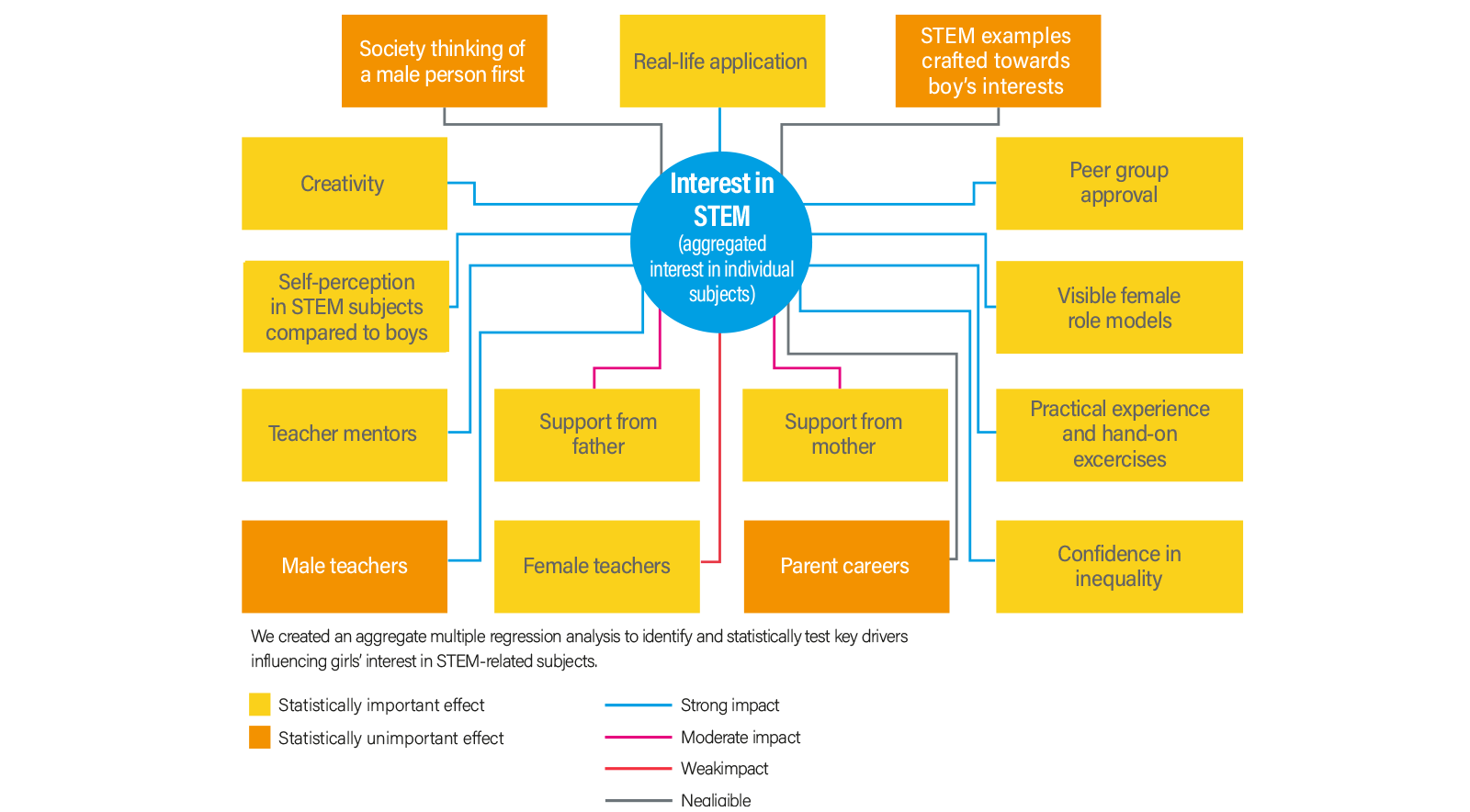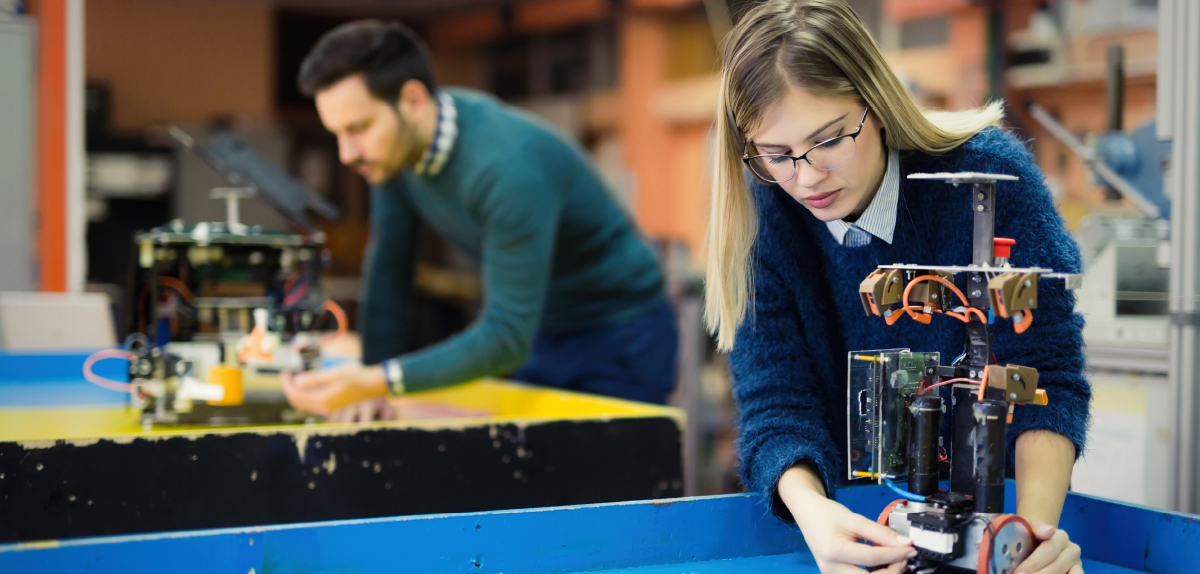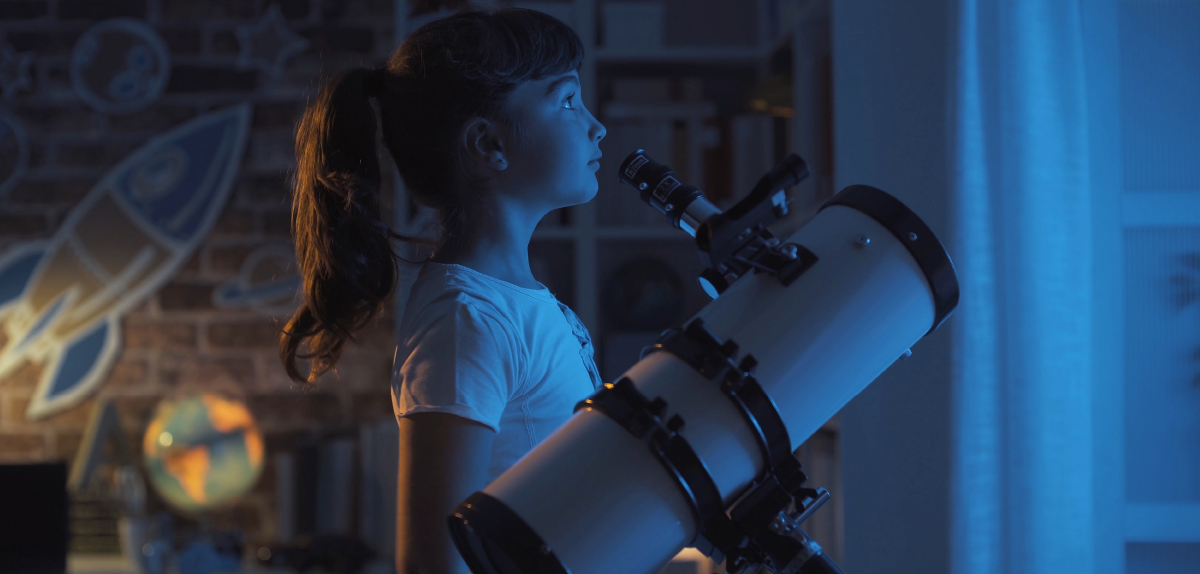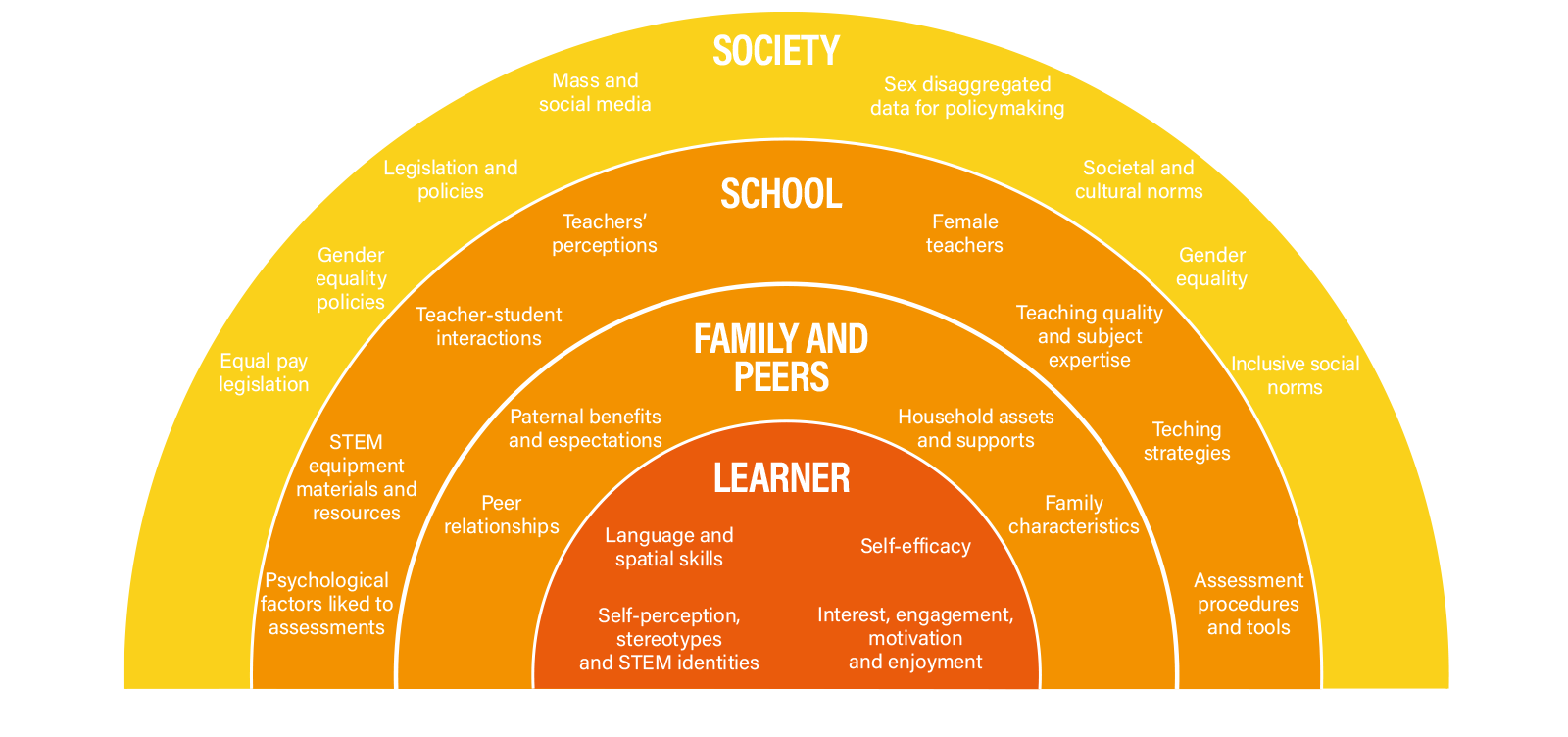STEM (for “Science, Technology, Engineering and Mathematics”) is a term coined during the first decade of the 21st century to refer to areas of knowledge in the fields of science, technology, engineering and mathematics.
Unfortunately, these subjects have earned their own acronym due to how few, in practice, choose the educational and professional paths related to them, nowadays. During the last few decades, this phenomenon has been evidenced throughout Europe: the interest over STEM sciences dwindles as young people advance in their educational process, as well as in their career path.
The interest over STEM sciences dwindles as young people advance in their educational process”
Indeed, studies show an even higher effect among women, where the gender gap leads them away from STEM fields at a higher rate and at earlier ages than men.
This reality implies a constant loss, at all ages, of human potential from STEM sciences to other areas of knowledge, leading to a lower number of researchers and technology professionals in society.
However, the lack of STEM professionals is not just an inconvenience when it comes to hiring industry professionals, but also a burden for society: the weakness of STEM steers society away from sustainability and wellbeing objectives, prevents the citizenship from accessing the skills that are necessary in the 21st century and precludes us from preparing future generations for the jobs we cannot even devise yet.
Which factors have a greater impact in girl’s interest over STEM?
The main issues faced by STEM subjects today are not new, but have remained unchanged through time despite all the efforts undertaken until now since those first years of the 2000s. Why? What are the causes of this stagnation? After all, STEM careers are closely related to technological progress and, therefore, with wellbeing, sustainability, the advancement of our society, discovery and the comprehension of the universe we inhabit.
What is preventing us from fostering STEM sciences in our current society? The key is in ourselves, in all of us. Moving to action across all realms of society, helping our youth understand that there is a future in STEM--and particularly in space--, is the responsibility of all of society.
Even being aware that the analysis of the problems faced by STEM is encompassing and even broader than what a technical document can contain, the results and conclusions of WIA-E focus on five fundamental pillars. In the chronological order in which they are given, going from the individual to the group formed by Europe.

How to inspire and motivate children?
According to a publication by The Children’s Society, gender roles are acquired at very young ages, approximately at age 2, and it is at that precise moment where the first STEM obstacles are found: the kinds of toys, object colors, television content, behavior within the family unit, first interactions with children outside the family, etc.
A healthy and balanced relationship during growth is fundamental. This is the only way to be able to freely develop, without gender biases, so that boys and girls can pursue their own interests and likes without feeling obligated to make a specific choice or fearing being anyone’s deception, being delivered from external impositions.
Encouraging and helping children is much easier than it looks:
- Cooperating with early childhood and elementary school educators to help them build unbiased school environments, where there is room for all different professions. Also, fostering the contact of students with activities and toys that have no gender biases and stimulate skills closely linked to STEM (memory, mathematics, space vision...).
- Enriching the training programs of educators so that they continue their training in areas that are traditionally neglected, such as STEM, starting at an appropriate level. For example, we could mention the European Space Agency’s (ESA) ESERO program, aimed at training educators with sights on improving their aerospace sector-related STEM skills.
- Fostering agreements between industry and the educational sector to start the contact with STEM during the first years of life. Through motivational talks, classroom activities and advice, the industry can collaborate with the educational system to offer these opportunities to students.

Holding young talent
Over 70% of teenagers interviewed as part of RAL Space’s “Our space, our future” project, from different European countries, replied that, yes, they were interested in the aerospace sector. If interest was not the issue, then why would they cast aside their STEM projects? There was only one possible answer: interest is not everything. Just 41% of those interviewed showed interest in working as part of this sector in the future, despite confirming that STEM was indeed among their interests.
Therefore, the issue at these ages is matching the interest raised by science with the aspirations of our youth: they believe that their future cannot be in STEM, even if they like it. Why does our youth believe this? Among other reasons, we can find:
- A generalized cluelessness as to what one actually does in STEM and, in particular, the aerospace sector.
- Lack of financial resources to access educational programs that are intrinsically longer than others.
- Conceptual errors and subjects related to employment outlooks (“if you study engineering you will have to move to Germany to work; forget about Spain”).
- In the specific case of young women, significant stereotypes in regard to the professions that women “can” and/or “should” engage in. Here, there is a quite widespread phenomenon among teenage and pre-university women known as “the leaking pipe”: a constant, uninterrupted loss of young female talent exclusively caused by factors attributable to the gender gap.
Lack of educator training and obsolescence of the educational material when aiming to keep students interested (lack of inclusion of digital media, informational references made for grown-ups, outdated bibliography...).

In order to offset this lack of knowledge and the major socioeconomic stereotypes, society can contribute as follows:
- Offering assistance targeted at low-income communities, facilitating access to knowledge through exhibitions, talks, etc. This action is particularly powerful, since it not only reaches the youth, but also their families, strengthening the support for their aspirations and garnering the support of the family, which is often absent.
- Building a closer bond between the entities that are responsible for local employment and industry, with a twofold purpose: to put access to the aerospace industry within their reach and do away with the myth that in order to work in the space sector, it is essential to have an aerospace engineering degree.
- Connect with 21st century media in order to increase the exposure and visibility of science. From the launch of media campaigns (at a local, national or international level) to the creation of outreach content or the support of existing science communicators, industry can offer the youth new means to get informed about STEM and thereby maintain their curiosity and their dreams. This actions is highly effective, especially for young women, as we will later see, since the industry can offer young women new science role models—women like them who decided to follow the STEM path, which has led them to accomplish their aspirations.

STEM women
and the people in their lives
It would be unfair of us to focus all of the problems in young people. As we have already mentioned, STEM encouragement needs to come from all fronts and at all ages with the goal of strengthening its foothold in society. Relatives, friends and communities have a crucial impact in the choices and decision schemes of individuals.
How many of us have turned to a role model, such as a mother or professor, in search of advice when choosing our path? How many exhibitions in museums and cultural centers have we attended throughout our lives? It is inevitable to see oneself influenced by all of these agents in our close environment.
The push for STEM must come from all fronts and at all ages in order to maximize its entrenchment in society.”

Taking it one step further, we are constantly evaluated by those around us, being subject to opinions and judgment about everything we do and say. In particular, STEM women, professional role models, with a solid foothold in their fields of work, with important track-records and significant experience in the sector, are impacted by traditional, highly negative stereotypes in the form of gestures or rumors which are not based on their professional performance, but rather in prejudices that are wrongly acquired throughout our lives.
This fact does not only have important repercussions among these women (job desertion, career changes, lowered performance, eroded self-esteem, etc.), but also projects a skewed image of STEM women in society, sending the wrong message to our young of both sexes.
Families, relatives and social communities have a crucial impact on the choices and decision schemes of individuals.
It is for these, and other reasons, that the people in our lives and the value judgment that we receive from them are so important.
However, there are multiple solutions for these problems:
- Museums, libraries, cultural centers, religious centers—all of them can cooperate with the STEM sector to serve as means of communication with the youth, providing them with additional content to enrich their education and strengthen their interests not only through traditional means (exhibits, projections, etc.) but also through social networks, which is the great potential of the 21st century.

Women In Aerospace Europe (WIA-Europe) is a nonprofit organization committed to the promotion of female talent and leadership at all levels of the European space sector. While the association celebrates the achievements of the last few decades in accelerating the growth of female talent in the aerospace industry, WIA-Europe acknowledges that considerable differences still exist in the form of wage gaps, underrepresentation and inequality that must be addressed.
STEM Institutional
This last pillar includes both the educational system itself (education laws, teacher training programs, didactic resources, etc.), and the agents that can complement it (European initiatives, advertising campaigns, collaborations with industry, etc.).
The nuances of each country means that STEM promotion will be different in each member state of the Union: all of them promote it, but from different fronts and with different strategies. This offensive disparity is inefficient, since we could be talking about a common European framework to promote STEM sciences when, in reality, there are as many as there are countries.
A common framework would imply better leveraging the resources, allow each country to bring their experience in their strong points to the table and create more synergies between institutions and industry.
And while it is true that both industry in particular and society as a whole have less freedom in this regard, there are still solutions:
- Collaborating more with educational programs and with experiences that enable students to come into contact with the workplace earlier in their lives.
- Granting access to facilities to bring youth closer to STEM positions and to the work that is actually performed in our sector.
- Actively participating in mentoring programs where sector professionals can give a firsthand account of their life experiences to young people, answer their questions and guide them at different stages of their educational process.
Nowadays, our young talent needs a structured support to pursue their STEM aspirations. The limited choice of STEM subjects, especially among young people, has been an established trend during the last 30 years and it is necessary for educators, industry and institutions to join efforts to remedy this situation and usher them toward STEM careers. All agents of society can (and should) help promote STEM sciences among new generations.
The proposed initiatives are an example of the crucial role that associations such as WIA-E and companies of the aerospace sector have and should have in our more immediate future: inspiring children, encouraging the youth, and guiding professionals toward an exciting future in the space sector.





